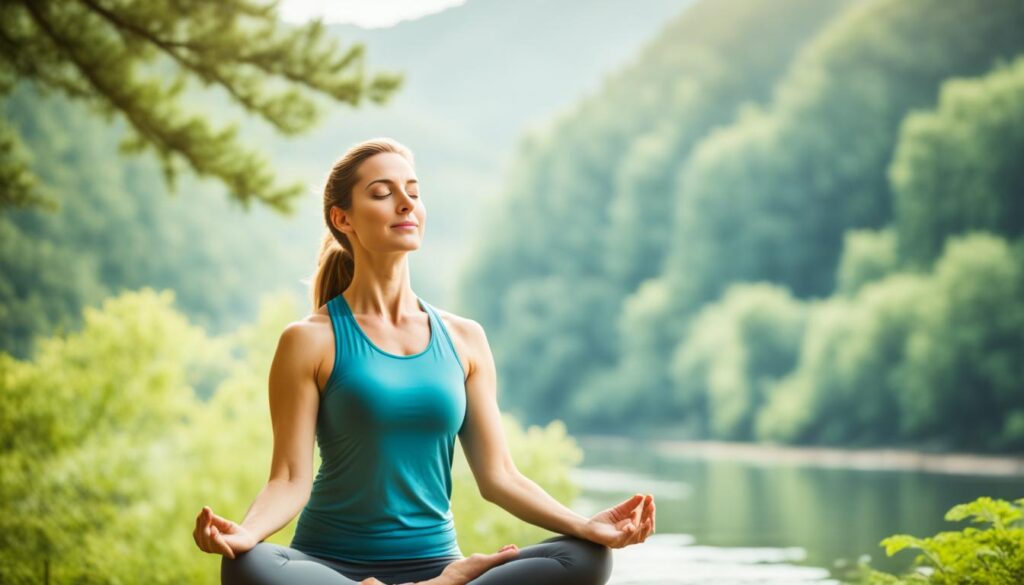In today’s fast-paced world, it may feel impossible to find moments of peace. But did you know that adding moments of calm to your daily routine could greatly enhance your overall well-being? A recent study found that those who regularly prioritize stillness experienced a 30% decrease in stress levels and reported feeling happier and more content.
Imagine being able to tap into a sense of inner peace, boost your creativity, and enhance your focus, all by simply taking a few moments to cultivate stillness in your life. The power of stillness is truly remarkable, and in the following sections, we will explore its key benefits and how you can incorporate it into your daily routine.
Key Takeaways:
- Practicing stillness can reduce stress levels by 30%.
- Regularly incorporating stillness into your routine can increase your overall contentment and happiness.
- Stillness provides a profound sense of inner peace.
- Practicing stillness boosts creativity and enhances focus.
- By cultivating moments of stillness, you can experience greater well-being and balance in your life.
The Benefits Of Stillness
When we embrace stillness, we open ourselves up to a myriad of incredible benefits that positively impact our overall well-being. Let’s explore these remarkable advantages:
1. Setting Intentions: By creating a quiet space and allowing stillness to enter our lives, we can set clear intentions and align them with our goals and dreams. Stillness provides the canvas upon which we can paint our aspirations.
2. Focus and Reflection: Amidst the chaos of daily life, stillness allows us to filter out distractions and direct our attention inward. We can reflect on our experiences, thoughts, and emotions, gaining valuable insights and a deeper understanding of ourselves.
3. Reducing External Stimuli: In a world filled with constant noise and distractions, stillness provides a much-needed respite. By intentionally seeking moments of stillness, we give ourselves the gift of peace and tranquility.
4. Calming the Nervous System: The practice of stillness has a profound impact on our nervous system, helping to reduce stress, anxiety, and overwhelm. It allows us to shift from a state of fight-or-flight to one of relaxation and calm.
5. Letting Go: Through stillness, we can release thoughts and worries that no longer serve us. It enables us to detach from negative emotions, cultivate a sense of surrender, and free ourselves from the burdens of the mind.
6. Tapping Into Intuition: Stillness opens a door to our intuition, our inner voice of wisdom. By quieting external voices and focusing inward, we can access our innate knowledge, make decisions aligned with our true selves, and navigate life’s challenges with clarity.
7. Staying Present: In a fast-paced world, stillness grounds us in the present moment. It helps us let go of regrets about the past and worries about the future, allowing us to fully embrace the beauty and joy of the present.
8. Bringing Clarity: Within stillness, we find clarity of thought and purpose. It enables us to see through the fog of confusion and uncertainty, offering a fresh perspective on life’s complexities and helping us make conscious choices.
9. Increasing Creativity: The unique space of stillness nurtures creativity within us. When we silence the noise around us, we tap into the wellspring of inspiration, leading to innovative ideas, breakthroughs, and artistic expression.
10. Improving Sleep: Stillness relaxes our minds and bodies, preparing us for restful sleep. By letting go of the day’s worries and embracing tranquility, we enhance our ability to attain a deep and rejuvenating slumber.
11. Coping with Adversity: Through the practice of stillness, we cultivate resilience and emotional strength. It enables us to find solace within, to face life’s challenges with grace and fortitude, and to emerge stronger on the other side.
Incorporating stillness into our lives grants us access to these transformative benefits. The power to find peace, clarify our thoughts, boost creativity, and navigate life’s ups and downs with resilience lies within each of us. Are you ready to embrace the benefits of stillness?
Helps You Let Go
When practicing stillness, we learn to focus on our thoughts without actively engaging in them. This process creates space for what serves us and helps us let go of what no longer serves our well-being.
By observing our thoughts without judgment, we can find peace and clarity within ourselves. Letting go of negative thoughts, worries, and anxieties becomes easier as we cultivate a sense of stillness. It allows us to release the mental burden that weighs us down and prevents us from experiencing true tranquility.
Letting go through practicing stillness doesn’t mean suppressing or ignoring our thoughts and emotions. Instead, it gives us the opportunity to acknowledge them without getting entangled in their grip. It enables us to detach and take a step back, creating a healthier relationship with our thoughts and emotions.
“Letting go gives us freedom and freedom is the only condition for happiness.” – Thich Nhat Hanh
Through stillness, we can let go of the constant stream of thoughts that often overwhelm us. It enables us to find a sense of calm acceptance and surrender to the present moment, freeing ourselves from the shackles of the past and worries about the future.
Letting go doesn’t mean we become complacent or indifferent. On the contrary, it empowers us to approach life with a greater sense of ease and resilience. We learn to accept the things we cannot change and focus on what is within our control.
As we practice stillness and let go, we create space for new possibilities and inner growth. We release attachments to outcomes and trust in the natural flow of life. This newfound sense of surrender allows us to embrace change, adapt to challenges, and find joy in the present moment.
Letting go through the practice of stillness is a transformative journey. It requires patience, self-compassion, and consistent practice. As we learn to release what no longer serves us, we pave the way for a more peaceful and fulfilling life.
Letting Go Exercise
- Sit comfortably in a quiet space, allowing yourself to relax and unwind.
- Take a few deep breaths, inhaling slowly through your nose and exhaling through your mouth.
- Bring your attention to your thoughts and observe them without judgment.
- Notice any thoughts or emotions that arise and remind yourself that you have the power to let them go.
- Visualize releasing these thoughts and emotions, imagining them flowing out of your mind and dissipating into the atmosphere.
- Repeat a calming mantra or affirmation, such as “I let go of what no longer serves me.”
- Continue observing your thoughts, gently letting go of any that arise, and returning to a state of stillness.
- Practice this exercise regularly to cultivate the art of letting go through stillness.

| Benefits of Letting Go Through Stillness | Description |
|---|---|
| Increased emotional well-being | By letting go of negative thoughts and emotions, we experience greater emotional balance and well-being. |
| Reduced stress and anxiety | Letting go helps alleviate stress and anxiety by releasing tension and promoting a state of calm. |
| Improved mental clarity | When we let go, our minds become clearer, allowing us to make better decisions and find creative solutions to challenges. |
| Enhanced self-acceptance | Letting go fosters self-compassion and self-acceptance, as we learn to embrace our imperfections and let go of self-judgment. |
| Greater resilience | Through the practice of letting go, we become more resilient and adaptable, navigating life’s ups and downs with grace and ease. |
Helps Tap Into The Intuition
Stillness is not just about finding peace and quiet in our surroundings; it is also about quieting the chaos within and listening to our own intuition. In a world filled with external voices and influences, practicing stillness allows us to tune into our inner wisdom and make decisions based on our own instincts and intuition.
When we tap into our intuition, we are able to access a deep well of knowledge and understanding that resides within us. It is a powerful tool that can guide us in making choices that align with our true selves and lead to greater fulfillment.
By taking the time to be still and quiet our minds, we create space for our intuition to rise to the surface. We become more attuned to the subtle cues and whispers that come from within, guiding us on our path. Whether it’s making a career change, embarking on a new creative endeavor, or navigating a relationship, our intuition can provide invaluable guidance and clarity.
“Intuition is the key to everything, in painting, filmmaking, business – everything. I think you could have an intellectual ability, but if you can sharpen your intuition, which they say is emotion and intellect joining together, then a knowingness occurs.”
– David Lynch
When we practice stillness, we create a sacred space within ourselves where we can listen to the whispers of our intuition. It is in this space that we can tap into our inner wisdom and trust ourselves to make decisions that are aligned with our highest good.
Fostering Intuition through Stillness
There are several practices that can help us tap into our intuition while practicing stillness:
- Meditation: Engage in a regular meditation practice to quiet the mind and connect with your intuition.
- Journaling: Spend time writing in a journal to explore your thoughts and feelings, and allow your intuition to come forth.
- Spending Time in Nature: Connect with the natural world and allow its beauty and serenity to inspire and align you with your inner voice.
- Listening to Inner Prompts: Pay attention to the little nudges and gut feelings that arise throughout your day, and trust them as guidance from your intuition.
By incorporating these practices into our lives, we can strengthen our connection to our intuition and cultivate a deep sense of trust in ourselves. The wisdom that arises from within can serve as a guiding light, leading us toward the path that is most aligned with our authentic selves.

Helps You Stay In The Present
Anxiety and stress can often consume us when we find ourselves dwelling on the past or worrying about the future. Our minds become cluttered with thoughts that take us away from experiencing the joy of the present moment. However, practicing stillness can help us stay grounded and fully embrace the here and now.
In the midst of our busy lives, taking moments of stillness allows us to pause and appreciate the little wonders that surround us. It is in these quiet moments that we can truly connect with our surroundings, our loved ones, and most importantly, ourselves.
“The present moment is the only moment where life exists.”
When we are present, we can engage fully in the activities we are involved in. Whether it’s having a conversation with a friend, enjoying a meal, or simply taking a walk in nature, being present allows us to savor the richness of each experience.
By practicing stillness, we cultivate mindfulness and train our minds to let go of distracting thoughts. We become more aware of our thoughts and emotions without getting caught up in them. This heightened sense of awareness helps us respond to situations with greater clarity and wisdom.
Let’s avoid letting our minds wander and miss out on the beauty of the present moment. Instead, let’s embrace the practice of stillness and stay present, allowing ourselves to fully engage in the gift of now.

Helps Bring Clarity
Stillness is a powerful practice that allows us to step back from the chaos of life, creating space for clarity to emerge. By embracing stillness, we can quiet the noise within, redirect our focus, and think clearly. This clarity enables us to gain a deeper understanding of our thoughts, emotions, and challenges, leading to effective problem-solving and decision-making.
When we pause and redirect our minds, we create an opportunity for clarity to arise. In the midst of confusion or overwhelm, stillness provides a calm retreat where we can gather our thoughts and find solutions. It allows us to detach ourselves from the external distractions that muddy our thinking, bringing us back to the present moment and helping us regain perspective.
“In the stillness, we find clarity.”
Practicing stillness fosters a sense of mental clarity that promotes focus, concentration, and mindfulness. By reducing mental clutter, we can better prioritize tasks, identify priorities, and achieve a state of flow. It enables us to see beyond the surface level and gain insights that may have been obscured in the busyness of our everyday lives.
With clarity, our thoughts become like a crystal-clear stream, guiding us towards the most effective and efficient actions. We become aware of our values, desires, and goals, allowing us to align our decisions and actions accordingly. By practicing stillness, we create a foundation of clarity that permeates all aspects of our lives, supporting us in finding meaning, direction, and purpose.
How Stillness Enhances Clarity
| Benefits of Stillness | Description |
|---|---|
| Enhanced focus | Redirecting attention and eliminating distractions improves concentration on the task at hand, leading to greater clarity. |
| Emotional regulation | Stillness allows us to observe and respond to emotions from a place of clarity, promoting emotional balance. |
| Mental decluttering | Quietening the mind through stillness helps clear away mental noise and create a space for clear thinking. |
| Improved decision-making | Clarity gained through stillness enables us to make informed, thoughtful decisions that align with our values and goals. |
| Deeper self-understanding | By stepping back from the chaos, we gain insight into ourselves, our thoughts, and our motivations, fostering self-awareness. |

Helps Increase Creativity
Practicing stillness is not only beneficial for finding inner peace and tranquility, but it also has a profound impact on our creativity. When we engage in stillness, we activate the right brain, which is associated with imagination and creative thinking. By tapping into our creative center through the practice of stillness, we open ourselves up to a world of endless possibilities and inspirations.
In today’s fast-paced and constantly buzzing world, it can be challenging to find moments of calm and silence. However, dedicating time to practicing stillness allows our minds to wander freely and explore new ideas. It is during these moments of stillness that our creativity truly flourishes.
During periods of stillness, our minds are unburdened by external distractions and demands, which enables us to fully immerse ourselves in the creative process. By letting go of our daily worries and stressors, we create space for innovative thoughts and fresh perspectives to emerge.
Moreover, stillness provides an opportunity for self-reflection and introspection. Through quiet contemplation, we gain deeper insights into ourselves and the world around us. This enhanced self-awareness fosters the ability to think outside the box and approach challenges from unique angles.
The practice of stillness not only increases our creativity but also enhances our problem-solving skills. By entering a state of calm and clarity, we become more receptive to new ideas and solutions. As a result, we can overcome creative blocks and find innovative ways to express ourselves.

Embracing stillness as a daily practice not only benefits our creative endeavors but also enriches our overall well-being. So, let’s make time for stillness, unlock our creative potential, and discover the extraordinary within ourselves.
Helps Improve Sleep
Practicing stillness can have a profound impact on sleep quality. By incorporating moments of calm and tranquility into our daily routine, we can achieve a relaxed state of mind that promotes better sleep. Whether it’s before bedtime or in the middle of a restless night, the practice of stillness can help us find restful slumber and wake up feeling refreshed.
The process of practicing stillness allows us to quiet our racing thoughts and reduce worries, enabling our minds to unwind from the stresses of the day. By embracing stillness, we create a space for inner peace and tranquility, providing a sense of calm that prepares us for a good night’s sleep.
Even during those nights when sleep seems elusive, the practice of stillness can come to the rescue. By focusing on deep, rhythmic breathing and gently redirecting our thoughts, we can quiet our restless minds and fall back asleep more easily.

Creating a soothing environment for sleep is essential, and practicing stillness is a powerful tool in achieving this. By incorporating practices such as meditation, mindfulness, or guided visualization, we can create moments of stillness that promote relaxation and prepare our minds and bodies for deep, restorative sleep.
“Practicing stillness has transformed my sleep quality. Instead of tossing and turning, my mind finds calm and peace, allowing me to drift into a deep slumber. It’s truly a game-changer!” – Christina, a dedicated practitioner of stillness.
Make stillness a part of your bedtime routine and experience the incredible benefits it brings to your sleep. The journey to improved sleep starts with embracing the power of stillness and cultivating moments of tranquility and peace.
Helps Cope With Adversity
Practicing stillness can be a powerful tool to cope with the adversities that life throws at us. While it may not change the situation we are facing, it can provide us with a sense of calm and resilience to navigate through challenging times.
When we practice stillness, we tap into our inner peace. It allows us to find a quiet space within ourselves, free from the chaos and turmoil that surrounds us. In this space, we can gather our thoughts, regain clarity, and find the strength to face adversity head-on.
Adversity can often leave us feeling overwhelmed and anxious. But through practicing stillness, we can cultivate a sense of inner strength and stability. It helps us develop a mindset that enables us to approach challenges with a calm and collected demeanor.
“In the midst of chaos, practicing stillness helps us find our center and maintain our balance.”
By embracing stillness, we learn to observe our thoughts and emotions without getting entangled in them. This ability allows us to detach ourselves from the negativity and stress that adversity brings, enabling us to respond with clarity and grace.
Ultimately, practicing stillness equips us with the tools we need to cope with adversity. It helps us connect with our inner wisdom and find solace amidst the storm. Whether it is through meditation, mindfulness, or simply taking a few moments of quiet reflection, the practice of stillness empowers us to face life’s challenges with resilience and inner strength.

The Benefits of Practicing Stillness in Adversity:
- Reduces stress and anxiety levels
- Increases emotional resilience
- Enhances problem-solving abilities
- Fosters a sense of calm and clarity
- Promotes self-compassion and self-care
How To Practice Stillness?
To truly reap the benefits of stillness, it is essential to incorporate regular practice into your daily routine. Here are some effective ways to practice stillness:
-
Take deep breaths: Deep breathing exercises can help calm the mind and relax the body. Find a quiet space, sit comfortably, and focus on taking slow, deep breaths. Feel the breath entering and leaving your body, allowing yourself to let go of tension and stress with each breath.
-
Practice whenever and wherever: Stillness can be practiced anywhere, at any time. Whether you’re sitting at your desk, waiting in line, or taking a walk in nature, take a moment to pause, tune into your surroundings, and be present in the moment.
-
Schedule practice time: Set aside dedicated time each day for practicing stillness. It could be early morning, during a lunch break, or before bedtime. By scheduling practice time, you prioritize stillness and make it a non-negotiable part of your daily routine.
-
Choose a favorite place: Find a quiet and peaceful space where you feel calm and relaxed. It could be a cozy corner in your home, a park bench, or even your garden. Creating a designated space for stillness can enhance your practice and make it easier to attain a state of tranquility.
-
Play soft music: Ambient and calming music can help create a serene atmosphere for practicing stillness. Choose instrumental tracks or nature sounds that resonate with you and aid in achieving a sense of inner peace.
-
Repeat calming mantras or affirmations: Mantras or affirmations can serve as powerful tools to quiet the mind and focus your thoughts. Choose phrases that resonate with you, such as “I am calm and centered” or “I invite peace and stillness into my life.” Repeat them silently or aloud during your practice.
Remember, practicing stillness is a personal journey, and what works for one person may not work for another. Explore different techniques, be patient with yourself, and find a practice that resonates with you. Embrace the moments of stillness amidst the chaos of daily life, and allow them to nourish your soul.
“Stillness is not the absence of movement or sound. It is the presence of inner tranquility that can be found within ourselves, even amidst the busiest of times.”
– Unknown
Physical Benefits of Stillness
Practicing stillness offers a range of physical benefits that contribute to overall well-being and vitality. It has a profound impact on our bodies, helping to alleviate stress, promote better sleep, enhance concentration, and achieve emotional balance.
One of the primary physical benefits of stillness is stress relief. By consciously creating moments of stillness, we allow our bodies to relax and unwind, reducing the harmful effects of stress hormones. This can lead to improved cardiovascular health, reduced muscle tension, and a sense of calmness.
Furthermore, stillness enhances our ability to concentrate and focus. In a world filled with distractions, taking time to quiet the mind can sharpen our cognitive abilities and increase mental clarity. By practicing stillness, we train our minds to remain present and fully engaged, leading to improved productivity and performance.
Improved sleep is another significant physical benefit of stillness. By embracing moments of stillness before bed, we create a peaceful environment for our bodies and minds to rest. This allows us to achieve a deep and restorative sleep, ensuring we wake up feeling refreshed and energized.
In addition, practicing stillness contributes to emotional balance. When we cultivate a regular stillness practice, we create space to process and regulate our emotions. This can lead to a greater sense of emotional well-being, increased resilience, and the ability to respond to challenging situations with equanimity.

| Physical Benefits of Stillness |
|---|
| Stress relief |
| Improved concentration |
| Better sleep quality |
| Enhanced emotional balance |
By incorporating stillness into our daily lives, we can experience these physical benefits, nurturing our bodies and promoting overall well-being. The power of stillness lies in its ability to create a harmonious balance between our inner and outer selves, allowing us to thrive both physically and mentally.
Mental Benefits of Stillness
Practicing stillness offers a multitude of mental benefits that can significantly improve our well-being. Let’s explore some of these benefits:
Increased Self-Awareness
Stillness allows us to become more attuned to ourselves and our inner world. It provides an opportunity for introspection and self-reflection, helping us gain a deeper understanding of our thoughts, emotions, and behaviors. By cultivating self-awareness, we can make more conscious choices and live a more authentic life.
Mindfulness
Engaging in stillness encourages us to be fully present in the moment, cultivating mindfulness. It involves paying attention to our thoughts, feelings, and sensations without judgment. Mindfulness helps us develop a greater sense of clarity, focus, and resilience in the face of challenges.
“In the midst of movement and chaos, keep stillness inside of you.” – Deepak Chopra
Observing Thoughts
By practicing stillness, we can observe our thoughts without getting carried away by them. This skill allows us to create distance from negative or repetitive thoughts, reducing their influence over our mental well-being. It empowers us to respond to our thoughts in a more objective and constructive manner.
Self-Reflection
Stillness provides a space for quiet contemplation and self-reflection. It allows us to look inward, examine our values, beliefs, and aspirations, and make adjustments if necessary. Self-reflection enables personal growth and helps align our actions with our true selves.
Positive Response to Challenges
When faced with challenges or difficult situations, stillness equips us with the tools to respond in a positive and proactive manner. It cultivates a sense of calm, resilience, and emotional balance, enabling us to navigate adversity with grace and fortitude.
Embracing the mental benefits of stillness can have a transformative impact on our overall well-being, allowing us to cultivate a deeper understanding of ourselves, regulate our emotions, and foster a positive mindset.

Creating Moments of Stillness
Practicing stillness is not limited to specific settings or circumstances. It can be cultivated in any situation or environment, allowing us to find moments of tranquility amidst the chaos of daily life. Here, we explore different strategies to create stillness and incorporate it into our routine.
Finding Intentional Pauses
One way to practice stillness is by intentionally pausing throughout the day. Whether it’s taking a short break from work, stepping outside for a breath of fresh air, or simply sitting quietly for a few minutes, these intentional pauses can help us reset our minds and regain focus.
Focus on the Breath
The breath is a powerful tool for centering ourselves and practicing stillness. By directing our attention to the rhythm of our breath, we can anchor our focus to the present moment and let go of distractions. Taking slow, deep breaths and feeling the sensation of each inhale and exhale can cultivate a sense of calm and stillness within.
Be Present and Practice Mindfulness
Mindfulness is a practice that involves bringing our attention to the present moment without judgment. By engaging our senses and becoming fully aware of our surroundings, we can immerse ourselves in the present and create a space for stillness to enter. Whether it’s savoring the taste of a warm cup of tea, observing the beauty of nature, or engaging in a mindful activity like yoga or meditation, being present helps us cultivate stillness.
| Strategies to Create Stillness | Usage |
|---|---|
| Intentional Pauses | Take short breaks throughout the day to reset the mind. |
| Focus on the Breath | Direct attention to the rhythm of the breath to cultivate calmness. |
| Be Present and Practice Mindfulness | Engage senses and immerse in the present moment without judgment. |
Finding Balance Between External Stimuli and Internal Peace
In today’s fast-paced world, we are constantly bombarded with external stimuli that can disrupt our sense of peace and stillness. Finding a balance between these external factors and our internal state is essential. This might involve setting boundaries with technology, creating a serene environment at home, or engaging in activities that bring us joy and tranquility.
By incorporating these practices into our lives, we can gradually create more moments of stillness. Remember that practicing stillness is a journey, and it may take time to find what works best for you. Embrace the process and allow yourself the space to cultivate inner calm and tranquility.

Conclusion
Incorporating moments of stillness into our daily lives can have profound effects on our overall well-being. By unlocking the power of stillness, we can find inner peace, boost creativity, enhance focus, and cultivate a sense of calm amidst the chaos of life. Practicing stillness is a journey that requires patience and dedication, but the rewards are worth it.
When we take the time to pause, reflect, and be present in the moment, we give ourselves the opportunity to recharge and rejuvenate. Stillness allows us to let go of thoughts and worries, tap into our intuition, and stay grounded in the present. It brings clarity to our minds and opens up new pathways for creativity.
By practicing stillness, we create space for inner peace and resilience, enabling us to cope with adversity and navigate life’s challenges with a calm and centered mindset. Whether it’s through deep breathing exercises, finding a quiet place, or practicing mindfulness, incorporating stillness into our daily routine can lead to a more balanced and fulfilling life.
FAQ
What are the key benefits of practicing stillness?
Practicing stillness can provide numerous benefits for one’s well-being, including finding inner peace, rejuvenating the mind, boosting creativity, and enhancing focus.
How does stillness help individuals let go?
Stillness allows individuals to set intentions, focus on thoughts and reflection, and reduce external stimuli. It helps calm the nervous system and acts as a stress reliever.
How does stillness help tap into intuition?
Stillness allows individuals to quiet external voices and listen to their intuition. It helps tune into inner wisdom and make decisions based on intuition rather than external influences.
How does stillness help individuals stay in the present?
Anxiety and stress often stem from dwelling on the past or worrying about the future. Stillness helps individuals stay in the present moment and appreciate the little moments of joy that can be missed when consumed by thoughts of the past or future.
How does stillness help bring clarity?
Stillness enables individuals to step back from problems and gain clarity in their thoughts. By pausing and redirecting the mind, individuals can think clearly and find solutions to challenges.
How does stillness help increase creativity?
Stillness activates the right brain, which is associated with creativity. By practicing stillness, individuals can tap into their creative center and gain new perspectives that lead to creative results.
How does stillness help improve sleep?
Practicing stillness can help individuals achieve a relaxed state of mind, reducing worries and promoting better sleep. Even in the midst of a restless night, stillness can aid in falling back asleep quickly.
How does stillness help cope with adversity?
Stillness allows individuals to tap into their inner peace, helping them cope with the adversities they face in life. While stillness may not change the situation, it can provide a sense of calm and resilience.
How can one practice stillness?
There are various ways to practice stillness, including taking deep breaths, practicing whenever and wherever, scheduling practice time, choosing a favorite place, playing soft music, and repeating calming mantras or affirmations.
What are the physical benefits of stillness?
Stillness provides physical benefits such as stress relief, improved concentration, better sleep, and enhanced emotional balance. It helps relax the body, improve cognitive abilities, and promote emotional well-being.
What are the mental benefits of stillness?
Stillness offers mental benefits including increased self-awareness, mindfulness, observing thoughts, self-reflection, and positive response to challenges. It helps individuals develop a deeper understanding of themselves, regulate emotions, and promote a positive mindset.
How can one create moments of stillness?
Stillness can be cultivated in any situation or environment. It can be practiced by taking intentional pauses, focusing on breath, being present, practicing mindfulness, and finding a balance between external stimuli and internal peace.









